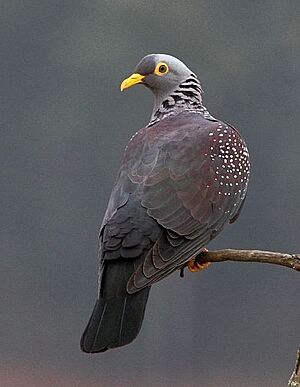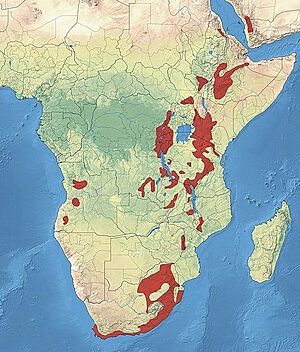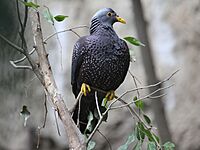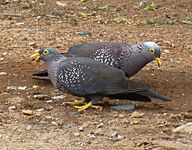African olive pigeon facts for kids
Quick facts for kids African olive pigeon |
|
|---|---|
 |
|
| Conservation status | |
| Scientific classification | |
| Genus: |
Columba
|
| Species: |
arquatrix
|
 |
|
| distribution | |
The African olive pigeon, also called the Rameron pigeon, is a type of pigeon. Its scientific name is Columba arquatrix. These birds live and breed in many parts of eastern and southern Africa, from Ethiopia all the way to the Cape. You can also find them in western Angola, southwestern Saudi Arabia, and northern Yemen. They are common in some areas, but their specific habitat needs mean they aren't everywhere.
Contents
What Does the African Olive Pigeon Look Like?
Adult male African olive pigeons are large birds. They are about 37 to 42 cm (15 to 17 in) long. They weigh between 300 to 450 g (11 to 16 oz). Their back and wings are a deep maroon color. Their shoulders have many white spots.
Their belly and chest are also maroon with lots of white spots. Their head is grey, and they have yellow skin around their eyes. Their beak is yellow too. The feathers on their neck are streaked with maroon and white. These feathers are used when the bird wants to impress another pigeon. The underside of their wings and tail are dark grey. Their feet are yellow.
Female pigeons look very similar to males. However, their colors are a bit duller. Young pigeons have dark brown instead of maroon and grey. Their bare skin parts are a dull greenish-yellow. The edges of their wing feathers are light-colored. When this pigeon flies, it looks very dark. It flies quickly, with regular wing beats. It also makes a sharp flick of its wings sometimes. This is common for most pigeons. Their call is a loud coo coo.
Where Do African Olive Pigeons Live?
These pigeons prefer cool and moist forests. They usually live high up in the trees. You can find them at altitudes above 1,400 m (4,600 ft). Sometimes, they live as low as 700 m (2,300 ft). They can also live in mountain fynbos (a type of plant area). They use areas where trees have grown back or clearings. They might even feed on farms if people don't bother them.
How Do African Olive Pigeons Behave?
How Do They Breed?
The African olive pigeon builds a large nest out of sticks. They build these nests high in trees, sometimes up to 15 m (49 ft) off the ground. The female usually lays one white egg, but sometimes two. The parents sit on the eggs for 17 to 20 days until they hatch. The young chicks are ready to fly about 20 days after hatching.
The male pigeon performs a special dance to attract a mate. He bows deeply. He also has a special flight display. He flies up high, claps his wings, and then glides slowly back down.
What Do They Eat?
African olive pigeons mostly eat fruit and berries. They usually pick these foods from the treetops. However, they will also go down to the ground to eat fallen fruit. Sometimes, they eat insects and caterpillars. In the southern parts of Africa, they really like the fruit of a plant called bugweed. This plant is not native to the area and can spread quickly.
These pigeons often fly long distances from where they sleep to find food. Young pigeons or those not breeding often fly together in groups.
African olive pigeons also eat soil. This is called geophagy. They have been seen eating clay soil. This soil has a basic pH and lots of sodium. Scientists believe they do this to get extra minerals for their diet. It also helps balance the acid from the fruits they eat.
Gallery





